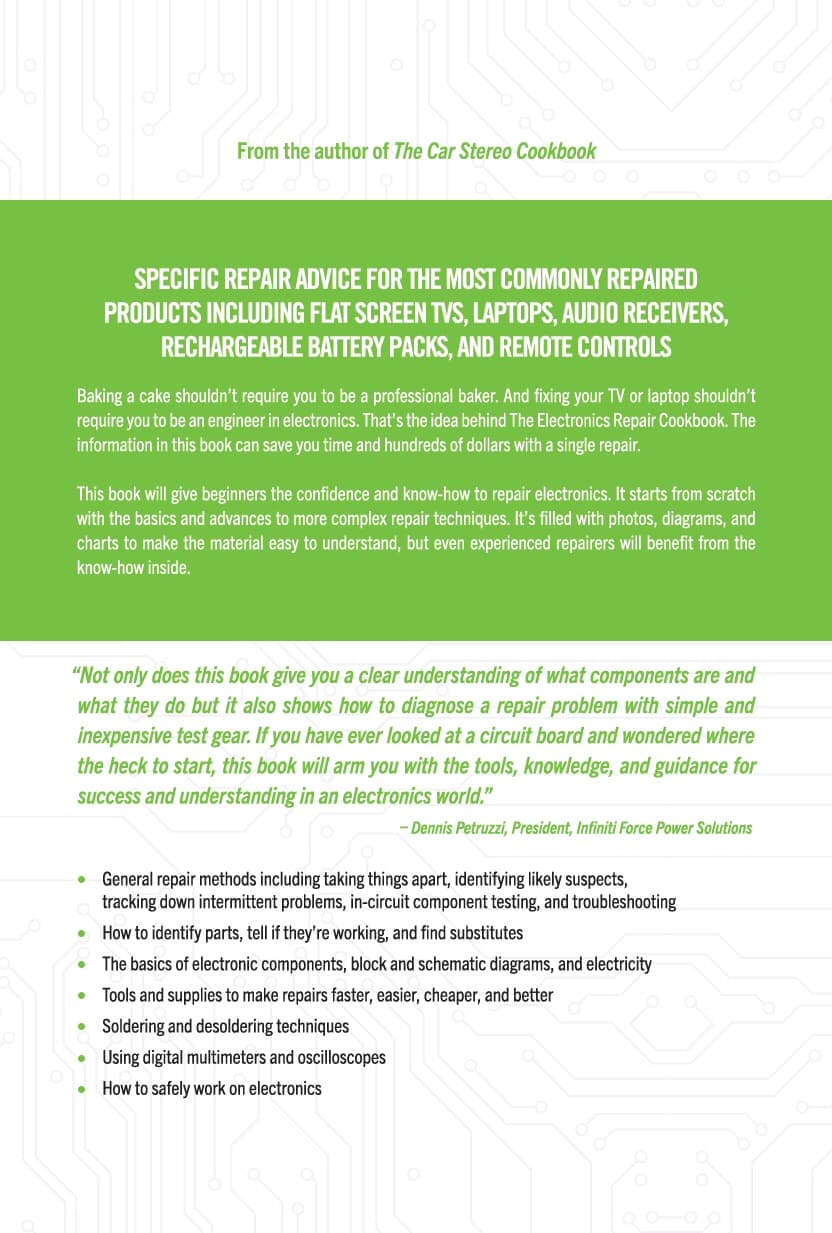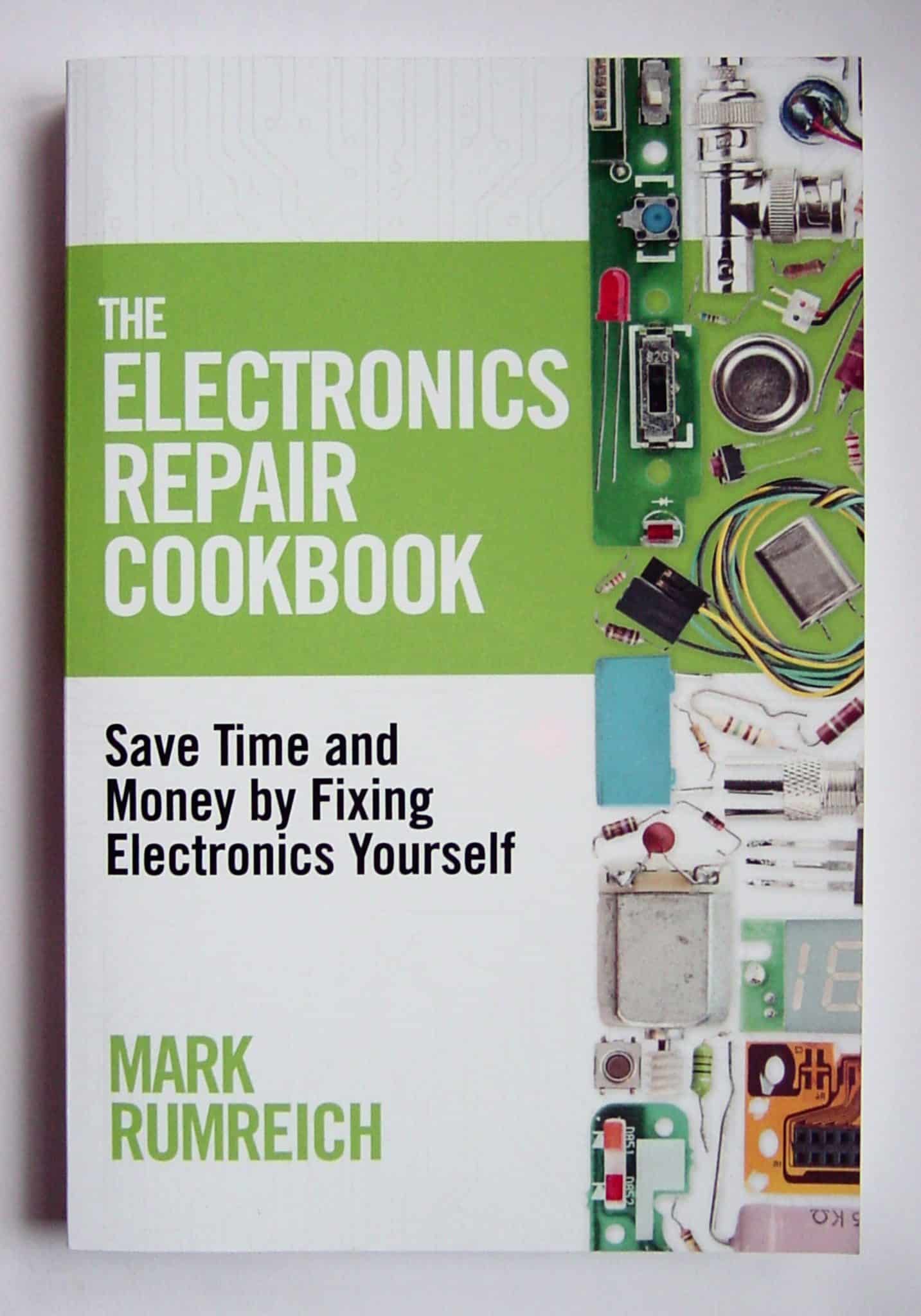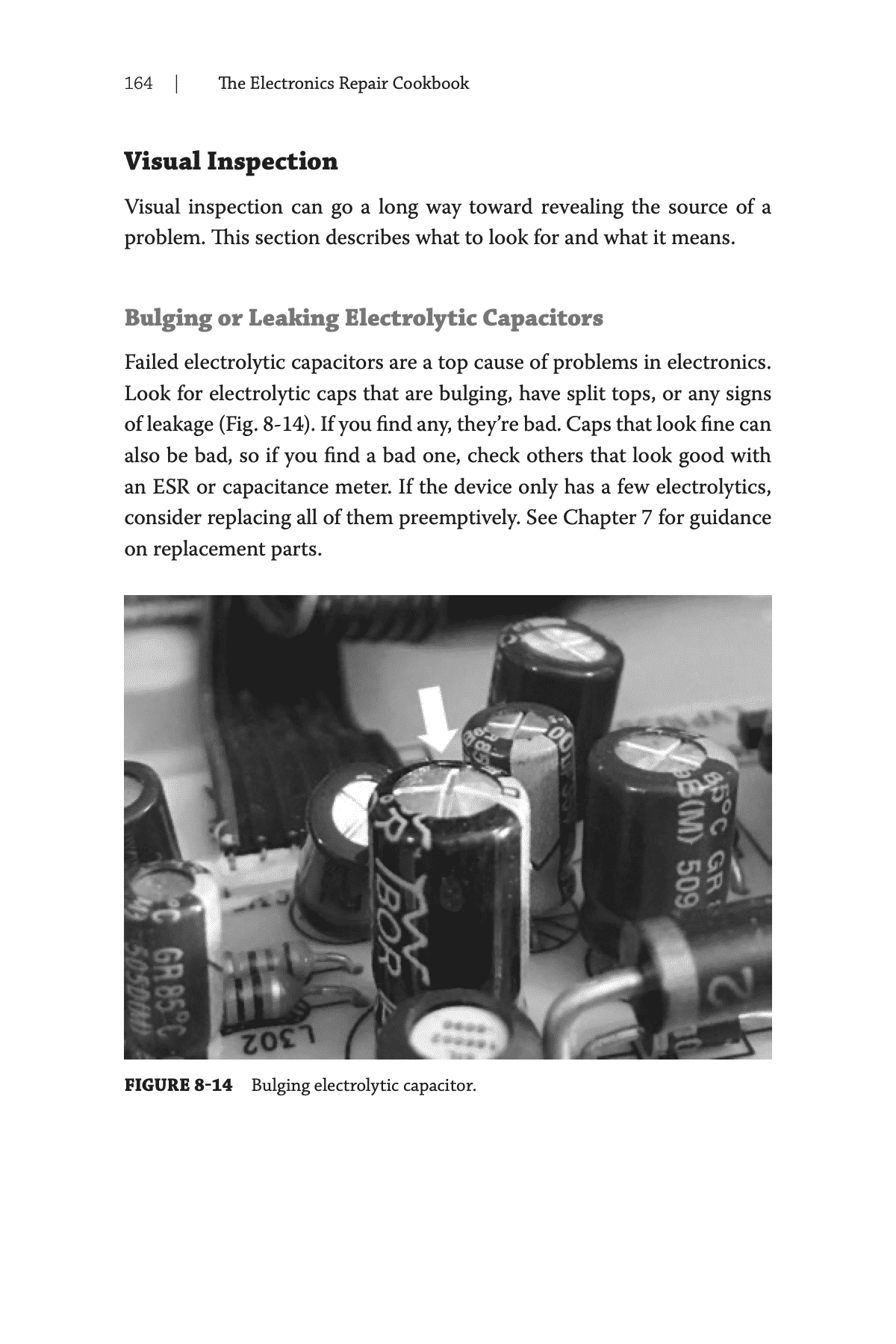The Electronics Repair Cookbook
SPECIFIC REPAIR ADVICE FOR THE MOST COMMONLY REPAIRED PRODUCTS INCLUDING FLAT SCREEN TVS, LAPTOPS, AUDIO RECEIVERS, RECHARGEABLE BATTERY PACKS, AND REMOTE CONTROLS
From the author of The Car Stereo Cookbook
What is this book about?
Baking a cake shouldn't require you to be a professional baker. And fixing your TV or laptop shouldn't require you to be an engineer in electronics. That's the idea behind The Electronics Repair Cookbook. The information in this book can save you time and hundreds of dollars with a single repair.
This book will give beginners the confidence and know-how to repair electronics. It starts from scratch with the basics and advances to more complex repair techniques. It's filled with photos, diagrams, and charts to make the material easy to understand, but even experienced repairers will benefit from the know-how inside.
Who is this book about?
This book will give beginners the confidence and know-how to repair electronics. It starts from scratch with the basics and advances to more complex repair techniques.
It’s filled with photos, diagrams, and charts to make the material easy to understand, but even experienced repairers will benefit from the know-how inside.
Download a sample
Download this free sample. It contains 92 pages (PDF), full table of contents, and several full chapters.



Key learnings
Book format
You can purchase this book in paperback or eBook format from Amazon.
Paperback:
eBook:
How is this book organized?
If you have no electronics background, start with Chapter 2 and work your way forward. If you do have some electronics experience, you’ll be able to move quickly through the material in the early chapters. But don’t skip them entirely; there are useful tips for experienced repairers in every chapter.
Chapter 2, “Safety.” This chapter discusses safe working practices for electronics repair. Some hazards are obvious, but others, such as charged capacitors in electronics that are unplugged and off or high voltage in battery-operated devices, are not so obvious.
Chapter 3, “Electronics Basics.” If you’re new to electronics, this chapter will introduce you to the basics of electronic components, block and schematic diagrams, and electricity.
Chapter 4, “Equipment and Supplies.” Repairing electronics requires some specialized supplies and equipment. You may already have some of what you’ll need. The real value of this chap- ter is that it lets you discover something to make repairs faster, easier, cheaper, or better. It’s organized by basic supplies, hand tools, and equipment from basic to advanced.
Chapter 5, “Soldering and Desoldering.” Knowing how to solder and desolder is a necessary skill for electronics repair. With some knowledge and a little practice, everyone can learn to solder well enough for basic repair work. This chapter provides the knowl- edge; you’ll have to do the practicing on your own. This chapter also covers printed circuit board (PCB) trace repair, replacing heat-sinked devices, and special techniques for surface-mount devices.
Chapter 6, “Using Test Equipment.” This chapter explains the basics of how to use the two most important pieces of test equipment for electronics repair: digital multimeters and oscilloscopes. This chapter shows what the equipment can be used for and its ease of use.
Chapter 7, “Part Identification, Testing, and Substitution.” This chapter is about how to identify parts, tell whether they’re working, and find a substitute, if needed. The procedures for checking parts in this chapter assume that the part is out of circuit.
Chapter 8, “General Repairs and Troubleshooting.” This chapter provides repair guidance that can be applied to any electronic device. Topics include poor candidates for repair, taking it apart, what to look for in a visual inspection, likely suspects, intermittent problems, and in-circuit component testing. The second half of the chapter is devoted to the art of troubleshooting. Topics include resources for understanding the system, troubleshooting strategy, power supply troubleshooting, and transistor circuitry troubleshooting.
Chapter 9, “Product-Specific Repairs.” This chapter provides specific repair advice for the most commonly repaired products, including audio receivers, rechargeable battery packs, flat screen TVs, laptops, and remote controls.
Ready to learn?
This book is available in two versions: eBook (Kindle) and print (paperback).
Indicative price: US$24.95
Your purchase is fulfilled by Amazon. For refunds or other issues, please contact Amazon..
Full table of contents
C H A P T E R 1
Before You Begin 1
Introduction 1
How This Book Is Organized 2
C H A P T E R 2
Safety 5
High Voltage 5
Electrolytic Capacitors 5
Inverter Circuits 6
Lasers 7
Solder and Soldering 7
Solvents and Chemicals 7
Eye Protection 8
Childproof Your Work Area 8
Don’t Work Alone 8
Electronic Waste Disposal 8
C H A P T E R 3
Electronics Basics 9
Introduction to Components 9
Resistors 9
Potentiometers 9
Capacitors 11
Inductors 11
Diodes 12
Transistors 12
Integrated Circuits 14
Transformers 14
Relays 15
Introduction to Schematics 16
Block Diagrams versus Schematics 16
Component Symbols 18
Introduction to Electricity 19
Basic Units of Electricity 19
Ohm’s Law 20
Power Formulas 20
Batteries in Series 20
Resistors in Series and Parallel 21
Capacitors in Parallel 22
AC versus DC 22
C H A P T E R 4
Equipment and Supplies 25
Basic Supplies 25
Electrical Contact Cleaner Sprays 25
Air Duster 26
Freeze Mist 27
Solder 28
Solder Wick 28
Heat-Shrink Tubing 28
Electrical Tape 30
Heat-Sink Compound 30
Nail Polish 31
Wire Ties 31
Solvents 32
Glues 33
Clip Leads 35
Crimp Connectors 36
Hand Tools 38
Needle-Nose Pliers 38
Wire Cutters 38
Wire Stripper 39
X-Acto Knife 40
Precision Screwdriver Set 40
JIS (Japanese Industrial Standard) Screwdriver Set 42
Security-Bit Set 44
Solder Sucker 45
Tweezers 45
Hemostats 45
Pin Vise 46
Dental Pick 46
Crimper 46
Strain-Relief Pliers 47
Nut-Driver Set 47
Basic Equipment 48
Soldering Iron/Soldering Station 48
Digital Multimeter 50
Magnifiers: OptiVISOR/Magnifier Lamp 51
Antistatic Mat and Wrist Strap 53
Intermediate Equipment 54
Heat Gun 54
Digital Calipers 55
Panavise 56
Dummy Loads 56
Advanced Equipment 58
Power Supply 59
ESR Meter 60
Oscilloscope 62
Function Generator 64
Isolation Transformer 64
C H A P T E R 5
Soldering and Desoldering 67
Soldering 67
Proper Tip Size and Temperature 67
Use the Right Solder 68
How to Solder 71
Flux Removal after Soldering 72
Desoldering 72
Solder Wick 73
Solder Suckers 74
Flux Pen 74
Add Solder 74
Use a Pin Vise 75
Clip Instead of Desolder 76
PC Board Trace Repair 78
Heat-Sinked Devices 80
Heat-Sink Compound 80
Thermal Pads 81
Mica Insulators 83
Bolt Down, Then Solder 83
Soldering and Desoldering Surface-Mount Parts 84
C H A P T E R 6
Using Test Equipment 87
Using a Digital Multimeter 87
General Measurement Procedure 87
Continuity Mode 90
Current Measurement 90
Diode Test 91
Using an Oscilloscope 93
Scope Probes 93
Probe Compensation 94
C H A P T E R 7
Part Identification, Testing, and Substitution 97
Counterfeit and Off-Brand Parts 97
Resistors 98
Identifying Resistance Value and Tolerance 99
Power Rating 102
Substitution 102
Potentiometers 103
Pots Used as Controls 104
Pots Used for Calibration 104
Other Pot Parameters and Substitution 105
Capacitors 106
Electrolytic Capacitors 106
Discharging Electrolytic Capacitors 108
Replacing Electrolytic Capacitors 110
Tantalum Capacitors 111
Film Capacitors 113
Ceramic Capacitors 113
Replacing Ceramic Capacitors 115
Inductors 115
Replacing Inductors 116
Diodes 117
Signal Diodes 118
Rectifier Diodes 118
Schottky Diodes 118
Zener Diodes 119
Varactor Diodes 119
Transistors 119
Transistor Packages 120
Transistor Failure Modes 121
Transistor Substitution 123
Voltage Regulators 124
Checking Regulators 125
Integrated Circuits 125
IC Packages 126
IC Testing 126
IC Substitution 127
Varistors 128
Varistor Identification and Replacement 129
Thermistors 129
Thermistor Identification and Replacement 130
Fuses 130
Fuse Failure 131
Fuse Replacement 131
Switches 132
Pole and Throw Terminology 133
Switch Function 135
Try Contact Cleaner 135
Replacement and Substitution 135
Transformers 137
Transformer Failure 138
Transformer Replacement and Substitution 138
Relays 139
Relay Testing 140
Replacement and Substitution 140
Analog Meters 141
Stuck Needle Fixes 142
Meter Replacement and Substitution 143
AC Adapters 144
AC Adapter Basics 144
Testing AC Adapters for a Bad Cable 145
Testing AC Adapters for Correct Output Voltage 145
AC Adapter Repair 146
AC Adapter Substitution 149
Component Test Summary 150
C H A P T E R 8
General Repairs and Troubleshooting 151
Is It Worth Fixing? 151
Poor Candidates for Repair 152
How Did It Break? 152
First Things to Check 153
Is It Getting Power? 153
Check the Fuse 153
Unplug for a Few Minutes 153
Factory Reset 153
Taking It Apart 154
Screws under Feet and Labels 154
Hidden Tabs 155
Cutting It Apart 156
Keeping Track of Which Screws Go Where 158
Take Pictures 160
Board Connectors 160
Visual Inspection 164
Bulging or Leaking Electrolytic Capacitors 164
Signs of Liquid or Corrosion Damage 165
Burned Components 165
Deformed Components 165
Melted Insulation on Wires 166
Components with a Hairline Crack 166
Bad Solder Joints 166
Components with a Chunk Missing 167
Discolored Areas on the PC Board or Cabinet 167
Likely Suspects 167
Electrolytic and Tantalum Capacitors 167
High-Power Components 167
I/O Components 168
Mechanical Components 168
Intermittent Problems 169
Get the Problem to Show Up 169
Likely Suspects for Intermittent Problems 169
In-Circuit Component Testing 170
In-Circuit versus Out-of-Circuit Testing 170
Measure In-Circuit 171
Lift One Lead 172
The Joy of Sets 173
Power the Circuit 173
More Joy of Sets 176
Troubleshooting 176
What Is Troubleshooting? 177
Understand the System 177
Divide and Conquer 179
Fix the Cause 180
Power Supply Troubleshooting 180
Transistor Circuitry Troubleshooting 182
Keeping a Repair Log 187
C H A P T E R 9
Product-Specific Repairs 191
Flat-Screen TVs 191
What’s Inside a Flat-Screen TV? 192
Taking a Flat-Screen TV Apart 194
Diagnosing Flat-Screen TV Problems 196
Laptop Computers 202
Finding Replacement Laptop Parts 203
Laptop Cracked Screen Replacement 203
Laptop Keyboard Replacement 205
Rechargeable Battery Packs 207
Replace or Repair? 207
Identifying Cell Types 207
Rebuilding a Battery Pack 209
Audio Receivers and Power Amps 211
Electrical Contact Problems 211
Blown Output Amplifier Circuitry 212
Loudspeakers 217
Driver Damage 217
Driver Replacement 218
Listening Test and Fine-Tuning 219
Additional Considerations for Woofer Substitution 220
Woofer Surround Repair 221
To Shim or Not to Shim 222
Surround Size and Edge Type 224
Shimless Surround Repair 227
Remote Controls 228
User Error 228
Battery Problems 229
Keypad Problems 230
Replacement 231
Part Suppliers 233
References 235
Index 237
Who is this book for?
This book will give beginners the confidence and know-how to repair electronics.
It starts from scratch with the basics and advances to more complex repair techniques.
It’s filled with photos, diagrams, and charts to make the material easy to understand, but even experienced repairers will benefit from the know-how inside.

About the author
I’ve always been interested in how things work. When I was a kid, people would give me their broken stuff and I’d take it apart to see what was inside. I was especially fascinated by electronics. How could all those tiny parts with wires sticking out of them make a radio or TV? I yearned to understand.
It wasn’t until studying electrical engineering that the mysteries really started to be revealed. Following my sophomore year at Purdue, RCA offered me a summer engineering internship at their Indianapolis headquarters. This is where RCA televisions were designed. Little did I know that this would be the start of more than 25-years of design work with them.
It quickly became clear that designing circuits for consumer electronics required a lot more expertise than what was taught in the engineering classroom. Fortunately, the RCA technical culture was very nurturing and experienced engineers were eager to share their knowledge with a beginner. Designing products to be reliable was a business necessity and required an intimate understanding of why circuits fail.
Once the word is out that you can fix things, there’s no shortage of repair projects that come your way. This is how it worked for me, and I’ve had the opportunity to fix an incredible number and variety of devices, I never say no.
Why did I write the Electronics Repair Cookbook? I read the top-selling books on electronics repair and thought I could do better for the reader. I believe that basic electronics repairs are within reach of most people given the right information and presented in the right way. The material needs to start from scratch then advance to more complex topics. It needs to be up-to-date and complement online information resources like YouTube and iFixit by filling the gaps. And like every cookbook, it needs to be easy to follow, have plenty of photos and a great index.
Thank you for considering my book, I wish you many successful repairs!
-- Mark Rumreich
Not only does this book give you a clear understanding of what components are and what they do but it also shows how to diagnose a repair problem with simple and inexpensive test gear. If you have ever looked at a circuit board and wondered where the heck to start, this book will arm you with the tools, knowledge, and guidance for success and understanding in an electronics world
Dennis Petruzzi
President, lnfiniti Force Power Solutions
© 2024 Tech Explorations

